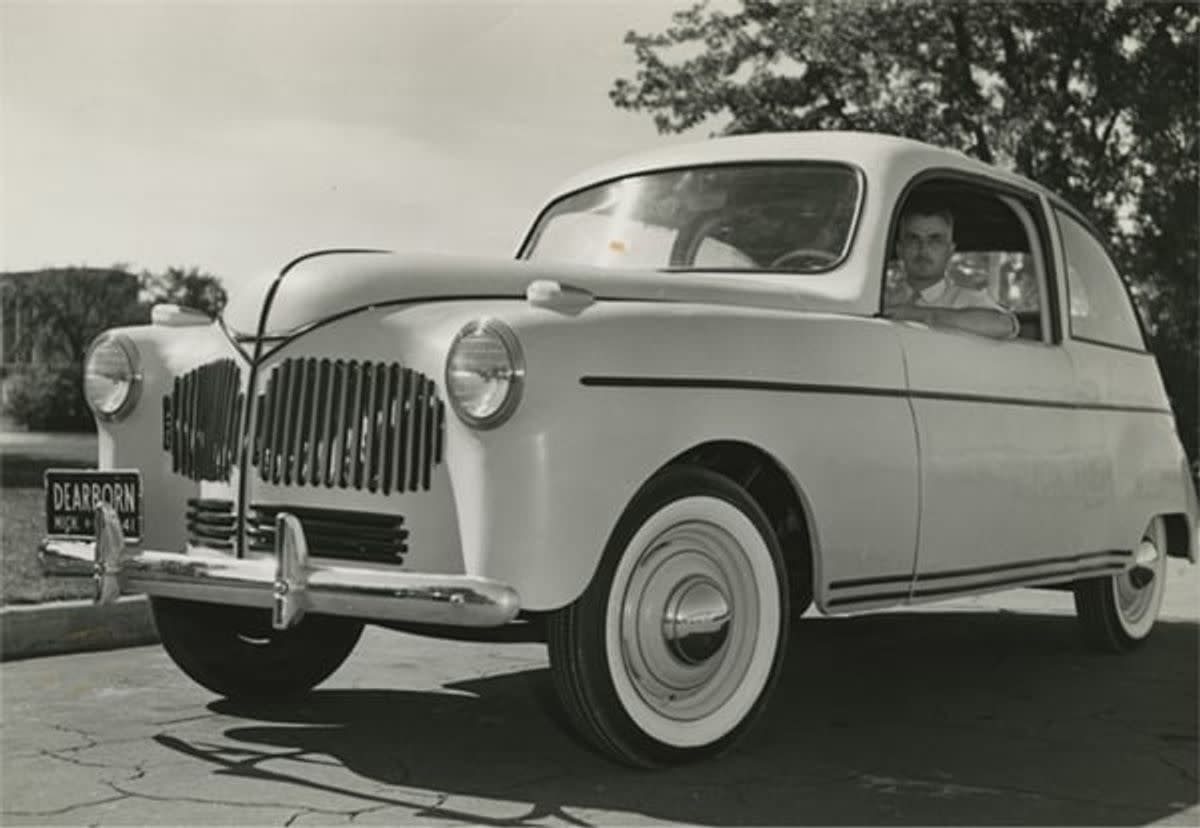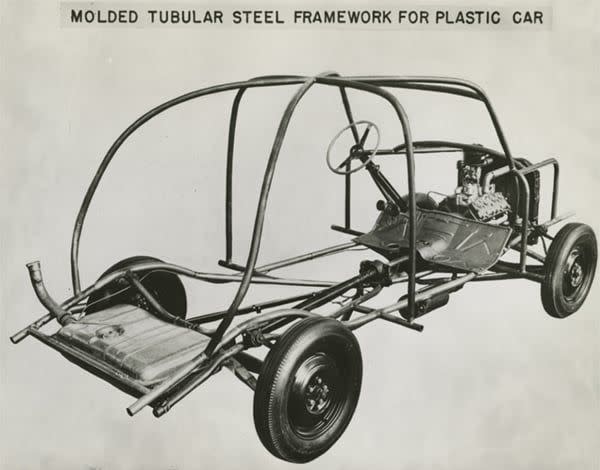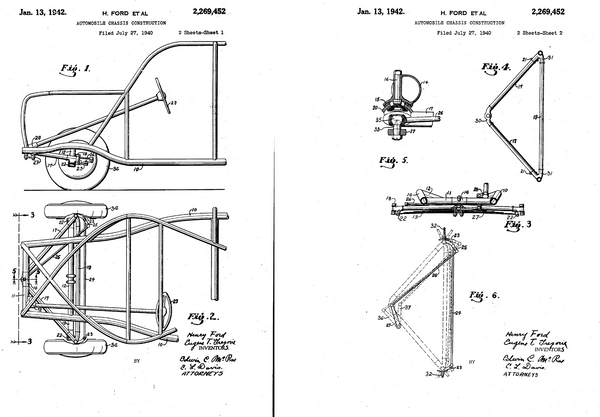Fact Check: It's Said Henry Ford Built a Car with Exterior Made of Soybean Plastic in the 1940s. Here's What to Know

- Oops!Something went wrong.Please try again later.
Claim:
Henry Ford built a car with an exterior body made of soybean plastic in the 1940s.
Rating:
Context:
There is no record of the exact formula Ford used to make the plastic components of the automobile. Contemporaneous sources claimed that in addition to soybeans, it was composed of other agricultural crops such as hemp, wheat and flax. One newspaper described the vehicle as "part salad and part automobile."
That the founder of Ford Motor Co., Henry Ford, invented a vehicle made of soybean-based plastic in the 1940s is a claim that has permeated corners of social media for more than a decade. From posts shared to Instagram in 2024 to photos on Facebook in 2018, Snopes found evidence of this claim existing in dozens of iterations across the web, including the below post shared to Reddit in 2020:
1941 Ford "Soybean Car", designed by Bob Gregorie & Lowell Overly, experimental agricultural plastic body
by u/graneflatsis in WeirdWheels
Snopes determined that the above image is genuine. However, according to The Henry Ford Museum of American Innovation, no record of the product's plastic formula exists. As such, the exact ingredients of the vehicle are unknown.
That being said, the book "Henry Ford and his Researchers: History of their Work with Soybeans, Soyfoods and Chemurgy" outlines Ford's soybean research between 1928 and 2011, with references to various newspaper articles and other contemporaneous sources. Based on this information, we've rated this claim as "True."
For example:
A July 28, 1941, article published in the Christian Science Monitor outlined an "experimental motor car" announced by Ford that was "made chiefly of plastic cellulose fibers."
An Aug. 14, 1941, article syndicated by The Associated Press reported that the product was the result of 12 years of laboratory work that resulted in a "plastic body composed of approximately 70% cellulose and 30% resin binder."
An Aug. 29, 1941, article in Detroit Free Press noted that the "Ford plastic car… made from farm products, was on display, as well as a near-by plot where the company has a growing soy-bean display from which the plastics are formed."
At 2,000 pounds — half the weight of a steel-bodied car at the time — the soybean car comprised 14 plastic panels attached to a tubular steel frame. The Henry Ford Museum of American Innovation notes that the "exact ingredients of the plastic panels are unknown because no record of the formula exists today."

(The Henry Ford Museum of American Innovation)
A 1988 article titled "Henry's Plastic Car: An Interview with Mr. Lowell E. Overly," published in the 2017 book "History of Industrial Uses of Soybeans," identified Overly as the "designer of the world's first plastic car." Overly worked at the Soybean Laboratory at Greenfield Village in Michigan, a lab established by Ford in 1929 to conduct chemical research on farm products. According to the interview:
Henry Ford was interested in finding new industrial uses for farm products and by 1931 he had settled on soybeans as having the most promise… Sometime in late 1937 or early 1938 large sheets of soybean plastic were made and Mr. Ford was so proud of it that he would jump up and down on it and brag to reporters or anybody else that happened to be around…
Later a rear deck-lid made from the plastic was fitted to Mr. Ford's car and he delighted in sitting it with an axe [ax] that he carried in the truck. However, Mr. Overlay recalls that the first time Mr. Ford struck it with an axe the deck lid cracked and the axe head went through it. Later, glass fibre was mixed into the plastic and the further precaution of a rubber boot was affixed to the sharp edge of the axe. The rebound would cause the ax to fly out of Mr. Ford's hands and gravel about fifteen feet before coming to rest. Satisfied with these results Mr. Ford gave orders to develop a small car with a plastic body.
The car had a tubular steel frame. The body panels were made of plastic composed of soybean fiber in a phenolic resin with formaldehyde used in the pregnation.
The Henry Ford Museum of American Innovation noted that the soybean car was unveiled at the annual Dearborn Days celebration on Aug. 13, 1941, and then trucked to the Michigan State Fairgrounds.
"By the end of the war the idea of a plastic car had fallen through the cracks due to energy being directed towards war recovery efforts," wrote the museum.
Snopes cross-referenced a patent number cited on a Wikipedia page describing the soybean car with Google Patents, and found patent number US2269452A, which described a "chassis frame on which a vehicle body may be mounted built up with interlaced cross members." It was filed by Ford and Gregorie Eugene on July 27, 1940, and was granted on Jan. 13, 1942. However, the patent did not make any reference to "soybean" or "plastic."

(Google Patents)
Sources:
Aoyagi, William Shurtleff; Akiko. History of Industrial Uses of Soybeans (Nonfood, Nonfeed) (660 CE-2017): Extensively Annotated Bibliography and Sourcebook. Soyinfo Center, 2017.
Henry, Ford, and Eugene T. Gregorie. Automobile Chassis Construction. US2269452A, 13 Jan. 1942, https://patents.google.com/patent/US2269452A/en?oq=2269452.
Henry Ford Soybean Car - Google Search. https://www.google.com/search?q=henry+ford+soybean+car&oq=henry+ford+soybean+car&gs_lcrp=EgZjaHJvbWUyBggAEEUYOTIGCAEQRRg8MgYIAhBFGDwyBggDEEUYPNIBCDI5NzFqMGo0qAIAsAIA&sourceid=chrome&ie=UTF-8. Accessed 20 May 2024.
Henry Ford's Hemp Car - MTFCA Forum. https://www.mtfca.com/phpBB3/viewtopic.php?t=26736. Accessed 20 May 2024.
Instagram. https://www.instagram.com/imtheimprobabledreamer/reel/C18l6XjNLgv/. Accessed 20 May 2024.
jlittle. "Henry Ford's Plastic Hemp Car | January 13th, 1942." Gary Crossley Ford, 13 Jan. 2023, https://www.garycrossleyford.com/blog/today-in-ford-history/henry-fords-plastic-hemp-car-january-13th-1942/.
Shurtleff, William, and Akiko Aoyagi. Henry Ford and His Researchers - History of Their Work with Soybeans, Soyfoods and Chemurgy (1928-2011): Extensively Annotated Bibliography and Sourcebook. Soyinfo Center, 2011.
"Making Automobiles Last During World War II." The National WWII Museum | New Orleans, 6 Jan. 2022, https://www.nationalww2museum.org/war/articles/automobile-rationing-world-war-ii.
"Soybean Car." Wikipedia, 24 Jan. 2024. Wikipedia, https://en.wikipedia.org/w/index.php?title=Soybean_car&oldid=1198746150.
Soybean Car - The Henry Ford. https://www.thehenryford.org/collections-and-research/digital-resources/popular-topics/soy-bean-car/. Accessed 20 May 2024.
Soybean Experimental Laboratory in Greenfield Village, circa 1940 - The Henry Ford. https://www.thehenryford.org/collections-and-research/digital-collections/artifact/361920/. Accessed 20 May 2024.


